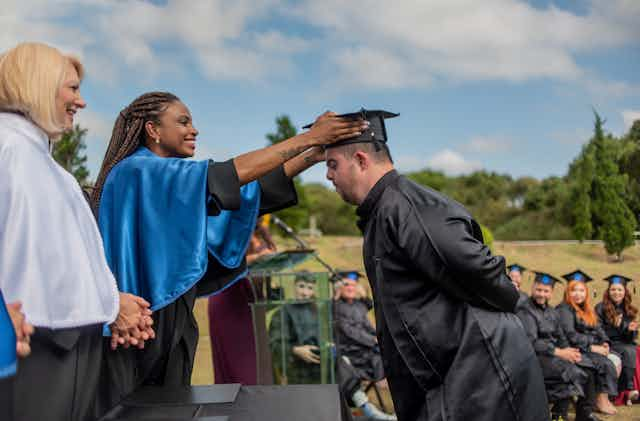For students with intellectual and developmental disabilities, opportunities to attend college may appear few and far between. But this is changing, thanks to inclusive postsecondary education – known as IPSE – programs at colleges across the United States. Here are some important things to know about these programs.
What is inclusive postsecondary education?
Inclusive postsecondary education refers to programs at colleges and technical schools that provide career and transitional training to people with intellectual and developmental disabilities. Transitional training helps these individuals move into adulthood, teaching them skills like how to set up a bank account, do laundry or cook for themselves.
How many of these programs exist nationwide?
Today, only about 2% of the approximately 420,000 eligible children with intellectual disabilities attend an IPSE program after high school. But the number of these programs at U.S. colleges and universities has more than doubled since 2009, from 148 to 328. Every state except for Wyoming has at least one such program, while states like California, Texas, New York, Florida and Massachusetts have numerous programs.
How did inclusive postsecondary education become important?
As recently as the 1970s, students with intellectual and developmental disabilities did not have equal access to public primary and secondary schools. The disparity was so glaring, parents in 26 states filed lawsuits to assert their children’s right to a public education.
In 1975, Congress passed a law now known as the Individuals with Disabilities Education Act – or IDEA – which makes a free public education available to students with intellectual and developmental disabilities. From 1975 through 2021, the U.S. education system went from excluding 1.8 million children with disabilities to providing more than 7.5 million children with an education.
Under the Individuals with Disabilities Education Act, most disabled students are required to have a detailed plan in place, no later than the age of 16, for how they will transition to adulthood. These plans must describe any resources needed for the transition period. Inclusive postsecondary education programs are considered one of the available resources.
How do inclusive postsecondary education programs work?
These programs focus on academic access, career development, campus membership and self-determination. Many programs use person-centered planning. This allows students to guide their own education. Students may work toward a certificate. However, inclusive postsecondary education programs do not lead to a college degree.
I teach at Kennesaw State University, where I serve as executive director of the oldest and largest of nine IPSE programs in Georgia: the Academy for Inclusive Learning and Social Growth. The academy currently enrolls 48 students.
Students may attend the academy for two years or four. Years one and two constitute the Academic, Social, and Career Enrichment Program. Years three and four are known as the Advanced Leadership and Career Development Program. After successfully completing the first two years, students may be invited back for the second two years. Students in each program earn a certificate that is recognized by the Georgia Board of Regents.
To complete a certificate, students must take 16 courses over four semesters. They must also successfully complete an internship and register social interaction hours. Each semester, students audit at least one course alongside their neurotypical peers. To graduate, students also must complete at least two additional trainings in the areas of culinary skills, computer technology, customer service or social media.
The academy provides extensive student support. Program advisers make sure that students excel and have their academic and social needs met. Course accommodations are made based on each student’s reading level and retention. Every student is assigned a peer mentor. The mentor accompanies them to classes and social gatherings.
Who is eligible for inclusive postsecondary education programs?
Admission requirements vary between different programs. For example, the academy where I work requires a minimum of a third grade reading level and the absence of significant behavioral problems. The academy also requires the completion of a psychological exam, a copy of any individualized education plan and an academic transcript. Most important, though, is the student’s desire to participate and complete all of the academic, social and career requirements for the certificate.
Do inclusive postsecondary education programs make a difference?
As a program director, one of the biggest benefits that I see is that students develop friend groups, often for the first time, and are able, depending upon the program, to live independent of their parents. At Kennesaw State University, about 75% of our 48 students reside on campus in university housing with a roommate.
There are a number of other benefits of inclusive postsecondary education programs. Research by Think College, a national research and evaluation center, indicates that a student who completes an inclusive postsecondary education program has a 65% chance of being employed within one year. This is compared with the 17% national employment rate for adults with a developmental or intellectual disability. Anecdotal evidence suggests that students in these programs have high rates of attendance and graduation. For example, the Academy for Inclusive Learning and Social Growth has an 85% graduation rate for students in our two-year program.
Despite all the benefits I’ve observed in my role, assessing all the elements of success across the field is still a challenge. That’s because these programs are complex, relatively new, and every program is different.
How do I learn more?
Families can learn more about IPSE programs by viewing the Think College website and also by contacting the disability and vocational rehabilitation agencies in their states.

